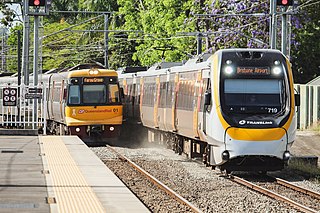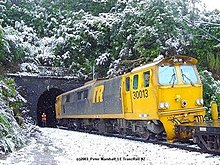
A dual gauge railway is a track that allows the passage of trains of two different track gauges. It is sometimes called a "mixed gauge" track. A dual gauge track consists of three rails. There will be two vital rails, one for each gauge close together and a third rail, a "common" rail further away. Sometimes, four rails are required using two outer and two inner rails to create the dual gauge. Dual gauge is not to be confused with a "third rail" or "check or guard rails".
Australians generally assumed in the 1850s that railways would be built by the private sector. Private companies built railways in the then colonies of Victoria, opened in 1854, and New South Wales, where the company was taken over by the government before completion in 1855, due to bankruptcy. South Australia's railways were government owned from the beginning, including a horse-drawn line opened in 1854 and a steam-powered line opened in 1856. In Victoria, the private railways were soon found not to be financially viable, and existing rail networks and their expansion was taken over by the colony. Government ownership also enabled railways to be built to promote development, even if not apparently viable in strictly financial terms. The railway systems spread from the colonial capitals, except in cases where geography dictated a choice of an alternate port.

With railways, a break of gauge occurs where a line of one gauge meets a line of a different gauge. Trains and rolling stock cannot run through without some form of conversion between gauges, and freight and passengers must otherwise be transshipped. A break of gauge adds delays, cost, and inconvenience.

The first railway in colonial South Australia was a horse-drawn tramway from the port of Goolwa on the Murray River to an ocean harbour at Port Elliot in 1854. Today the state has 1,600 mm broad gauge suburban railways in Adelaide, a number of country freight lines, as well as key 1,435 mm standard gauge links to other states.

Railways with a track gauge of 3 ft 6 in / 1,067 mm were first constructed as horse-drawn wagonways. From the mid-nineteenth century, the 3 ft 6 in gauge became widespread in the British Empire, and was adopted as a standard in Japan and Taiwan.

Rail gauges in Australia display significant variations, which has presented an extremely difficult problem for rail transport on the Australian continent for over 150 years. As of 2014, there is 11,801 kilometres (7,333 mi) of narrow-gauge railways, 17,381 kilometres (10,800 mi) of standard gauge railways and 3,221 kilometres (2,001 mi) of broad gauge railways.

The Queensland rail network, the first in the world to adopt 1,067 mm narrow gauge for a main line, and now the second largest narrow gauge network in the world, consists of:
Rail transport in Australia involves a number of narrow-gauge railways. In some states they formed the core statewide network, but in the others they were either a few government branch lines, or privately owned and operated branch lines, often for mining, logging or industrial use.

Barsi Light Railway (BLR) was a 202-mile (325 km) long, 2 ft 6 in narrow-gauge railway between Miraj and Latur in the state of Maharashtra in India. It was the brainchild of British engineer Everard Calthrop, and regarded as having revolutionised narrow-gauge railway construction in India.

The track gauge adopted by the mainline railways in Ireland is 5 ft 3 in. This unusual track gauge is otherwise found only in Australia, in the states of Victoria, southern New South Wales and South Australia, as well as in Brazil.
In Hong Kong, the three ex-KCR lines and the Light Rail service use 1,435 mmstandard gauge. New extensions to the Island Line and Kwun Tong Line, as well as the South Island Line, also use the 1,435 mm gauge.

The vast majority of North American railroads are standard gauge. Exceptions include some streetcar, subway and rapid transit systems, mining and tunneling operations, and some narrow-gauge lines particularly in the west, e.g. the isolated White Pass and Yukon Route system, and the former Newfoundland Railway.

The DH class was a class of diesel-hydraulic locomotives built by Walkers Limited, Maryborough for Queensland Railways between 1966 and 1974.
In rail transport modelling, Sn3½ is a scale/gauge combination derived from S scale to represent narrow gauge 3 ft 6 in track by using 16.5 mm gauge track. The scale is 1:64.
Most narrow-gauge railways in North America were constructed with 3 ft track gauge.
Asia has many narrow-gauge railways. The railways of Japan, Indonesia and the Philippines are predominantly 1,067 mm narrow gauge. Those in mainland Southeast Asia, which includes Vietnam, Cambodia, Laos, Thailand, Myanmar and Malaysia, are predominantly metre gauge. The proposed ASEAN Railway would be standard or dual gauge, using metre- and standard-gauge regional railway networks and linking Singapore through Malaysia, Thailand, Laos and Vietnam to China's standard-gauge rail network. In Western Asia, Jordan uses 1,050 mm narrow gauge.












